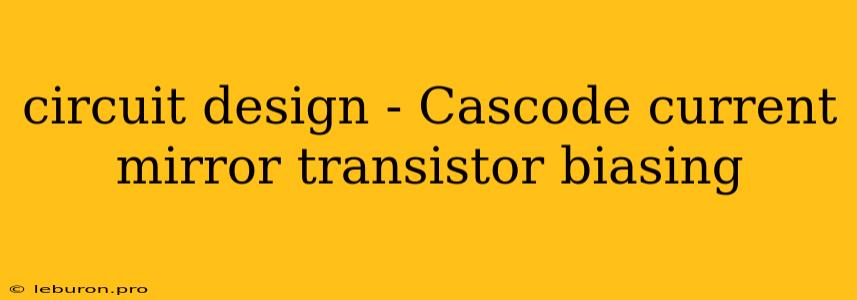Circuit design often involves the careful consideration of various components and their interactions. One crucial element in many circuits is the current mirror, a fundamental building block that replicates a current from one part of the circuit to another. Among the many variations of current mirrors, the cascode current mirror stands out for its excellent performance in terms of output impedance and current matching. This article delves into the intricacies of cascode current mirrors, exploring their advantages, limitations, and the intricacies of transistor biasing in their design.
Understanding the Essence of Cascode Current Mirrors
At its core, a current mirror is a circuit that utilizes transistors to copy a current from an input branch to an output branch. The basic principle relies on the inherent property of transistors – their collector current is directly proportional to their base current. In a simple current mirror, a single transistor mirrors the current flowing through a reference branch. However, this simple configuration suffers from a significant drawback: its limited output impedance.
Output impedance, a key parameter in circuit design, reflects a circuit's ability to maintain a constant output current despite variations in the load connected to it. A low output impedance implies that even slight changes in the load can significantly affect the output current, leading to instability and inaccuracies.
Here's where the cascode current mirror shines. By introducing an additional transistor in a cascode configuration, the output impedance is dramatically increased. This improvement stems from the cascaded nature of the transistors, where the first transistor serves as the current source, and the second acts as a voltage amplifier. The voltage gain provided by the second transistor contributes to the high output impedance, making the cascode current mirror a much more robust solution for many applications.
Delving Deeper: The Anatomy of a Cascode Current Mirror
Let's break down the structure of a cascode current mirror:
- Input Stage: The input stage typically consists of a bipolar junction transistor (BJT) or a field-effect transistor (FET) operating in the active region. This transistor serves as the current source, mirroring the input current.
- Cascode Stage: The cascode stage, usually another BJT or FET, follows the input stage. It functions as a voltage amplifier, buffering the output current from the input stage and significantly enhancing the output impedance.
The key to understanding the behavior of a cascode current mirror lies in appreciating the role of each transistor. The input stage dictates the output current, while the cascode stage ensures that this current remains stable despite changes in load conditions.
Advantages of Cascode Current Mirrors: A Summary
- High Output Impedance: This is the most significant advantage of a cascode current mirror. The cascode stage acts as a voltage amplifier, effectively increasing the output impedance compared to a simple current mirror.
- Improved Current Matching: Due to the increased output impedance, the cascode current mirror exhibits better current matching, meaning the mirrored current more closely resembles the reference current.
- Reduced Sensitivity to Variations: The cascode configuration helps minimize the impact of variations in transistor parameters, such as beta (current gain) and Early voltage, on the output current.
Biasing Considerations: Essential for Cascode Current Mirrors
To ensure optimal operation of a cascode current mirror, transistor biasing plays a crucial role. Proper biasing ensures that the transistors operate in the active region, where their current gain and output impedance are maximized.
- Base Current: The base current of the input stage transistor must be set appropriately to establish the desired output current. This often involves using a resistor or a current source to define the reference current.
- Emitter Current: The emitter current of the input stage transistor should be large enough to ensure the transistor operates in the active region, minimizing any distortion in the output current.
- Cascode Transistor Biasing: The cascode transistor also requires proper biasing. The base voltage of the cascode transistor should be carefully selected to achieve the desired voltage gain and output impedance.
Choosing the Right Biasing Techniques
Several methods are employed to achieve suitable biasing in a cascode current mirror:
- Voltage Divider Biasing: This technique involves a voltage divider network to set the base voltage of the input stage transistor. This is a simple and widely used approach.
- Current Source Biasing: A current source can be used to directly set the base current of the input stage transistor, providing more precise control over the output current.
- Emitter Follower Biasing: An emitter follower circuit can be incorporated to provide stable biasing for both the input and cascode stages.
Cascode Current Mirrors: Beyond the Basics
While the basic cascode current mirror provides excellent performance, there are variations and advanced implementations that further enhance its characteristics. These include:
- Wilson Current Mirror: This variation uses an additional transistor in the input stage to improve the current matching accuracy.
- Wideband Cascode Current Mirror: By utilizing feedback techniques, the bandwidth of the cascode current mirror can be expanded, making it suitable for high-frequency applications.
Conclusion
Cascode current mirrors are essential elements in many circuit designs, offering superior performance compared to their simpler counterparts. Their high output impedance, improved current matching, and reduced sensitivity to variations make them ideal for a wide range of applications. Understanding the principles of cascode current mirrors, their construction, and the intricacies of transistor biasing is crucial for designers seeking to incorporate this versatile circuit element effectively. From simple current mirroring tasks to complex circuit designs, the cascode current mirror continues to prove its worth as a powerful tool in the hands of skilled circuit designers.
